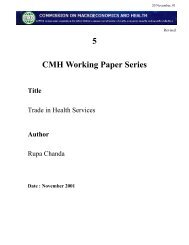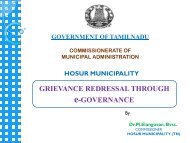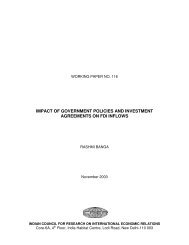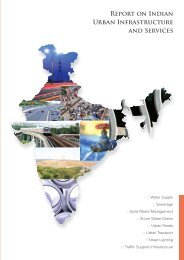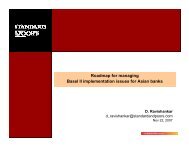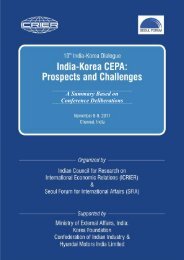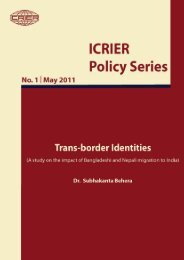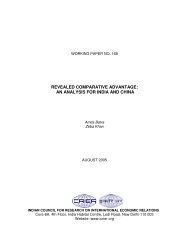Asia's Arc of Advantage - icrier
Asia's Arc of Advantage - icrier
Asia's Arc of Advantage - icrier
You also want an ePaper? Increase the reach of your titles
YUMPU automatically turns print PDFs into web optimized ePapers that Google loves.
South China Sea are the subject <strong>of</strong> maritime territorial disputes involving China, Vietnam,<br />
Philippines, Malaysia and Brunei. Not least, these tensions are also driven by the perception <strong>of</strong><br />
the South China Sea’s bountiful resources, from hydrocarbons to fishing.<br />
Asia’s emergence as the world’s economic powerhouse is most likely but not inevitable. The<br />
South China Sea exposes Asia’s leading challenge: the creation <strong>of</strong> regional institutions that<br />
address insecurity, reduce prospects <strong>of</strong> conflict, promote collective action on non-traditional<br />
security issues and provide the basis for a peaceful resolution <strong>of</strong> disputes under international<br />
law. 3 No such overarching architecture currently exists. The East Asia Summit has potential<br />
but is still weak and its future role in regional security undecided. Not only is the EAS limited<br />
to discussion <strong>of</strong> s<strong>of</strong>t security issues, it also lacks institutionalised mechanisms for follow-up.<br />
China cannot assert domination over the ASEAN-led EAS given its balanced, region-wide<br />
composition – hence its reluctance to accord a more vital role to this forum.<br />
***<br />
So, why exactly does the South China Sea come to occupy such an important role in regional<br />
geopolitics? To arrive at a reasoned conclusion, it is important to borrow the Han expression<br />
popularised by Deng Xiaoping: “Seek truth from facts”. Perhaps no reason is more significant<br />
than the remarkable erosion <strong>of</strong> another Deng dictum: “Hide your strength and bide your time”.<br />
Since 2009, the world has witnessed a new dimension <strong>of</strong> what was once known as China’s<br />
“peaceful rise” or “peaceful development”. Snowballing assertions <strong>of</strong> China’s “core interests”,<br />
which are now buttressed by a “China dream” based on the growing military power <strong>of</strong> an<br />
authoritarian state, have become a source <strong>of</strong> instability in Asia.<br />
Back in the “peaceful rise” days <strong>of</strong> 2002, China had been willing to sit down at the table with the<br />
ASEAN states to conclude a “Declaration on the Conduct <strong>of</strong> Parties in the South China Sea”,<br />
including respect for freedom <strong>of</strong> navigation in accord with universally recognised principles<br />
<strong>of</strong> international law, and an undertaking to resolve territorial and jurisdictional disputes by<br />
peaceful means, without resorting to the threat or use <strong>of</strong> force. 4 The Declaration set out the<br />
hope that it would lead to the adoption <strong>of</strong> a Code <strong>of</strong> Conduct in the South China Sea, which<br />
would further promote peace and stability in the region. 5 It is another matter that this hope<br />
has yet to be fulfilled, while territorial disputes have progressively escalated. An increasingly<br />
powerful China has become even more intransigent and difficult to bring to the negotiating<br />
table.<br />
The global financial crisis originating on Wall Street in 2008 was followed shortly thereafter<br />
by the advent <strong>of</strong> the Obama Presidency, which came to power pledging America’s withdrawal<br />
from foreign entanglements. Obama’s initial attempt at a “G-2” US-China condominium may<br />
have been short-lived, but was exploited by China as signalling the inevitability <strong>of</strong> US decline in<br />
Asia and to announce its own rise. The US has been reacting ever since to this ongoing power<br />
shift through its “pivot” or “rebalance” towards the Asia-Pacific, asserting its will to remain the<br />
region’s predominant power.<br />
3 G. John Ikenberry, “A New East Asian Security <strong>Arc</strong>hitecture: A Note From Our Guest,” Global Asia, March,<br />
2010, available at http://globalasia.org/V5N1_Spring_2010/G_John_Ikenberry.html.<br />
4 “Declaration on the Conduct <strong>of</strong> Parties in the South China Sea,” ASEAN, November 04, 2002, available at<br />
http://www.asean.org/asean/external-relations/china/item/declaration-on-the-conduct-<strong>of</strong>-parties-in-thesouth-china-sea.<br />
5 Ibid<br />
48 | Asia’s <strong>Arc</strong> <strong>of</strong> <strong>Advantage</strong>




